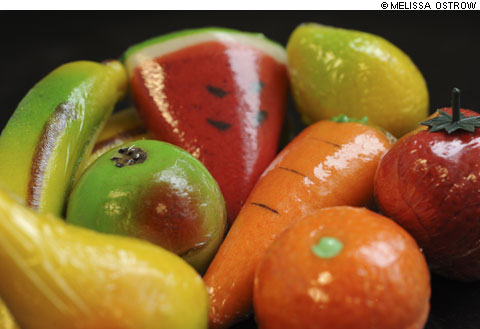
TRENDFODDER With the right marketing, could marzipan — mealy, saccharine almost paste disguised as fruits — be the Next Big Thing? |
Consider the chocolate-stout cupcake with bourbon frosting and bacon (a recent recipe posted to Beer Advocate): the fluffy, sweet frosting; the moist cake; the salty bacon; the sour notes of alcohol. It evokes childhood, vanished sun-dappled bakeries with Formica countertops, the slaughterhouse and barroom scuffles. This cupcake is at once naïve and knowing, innocent and experienced.
And it encapsulates the fin de siècle of the last decade's reigning food trends. We live in a time when food can achieve Bieber-like saturation. Probiotic yogurt. Organic soda. Sliders. Pundits have discussed their slightest fluctuations and socio-economic implications to death. What is it about food trends that so captivates our attention? Is it the hand of the market or the will of the people? Can any food achieve the ubiquity of the cupcake, or bacon's Olympian heights?
We needed answers. We found one of the least appealing, most obscure desserts imaginable, then turned to those in the know. Could any food become trendy? Could . . . marzipan?
Our Eliza Doolittle is a cloyingly sweet, bland paste made from almonds and sugar, usually painted with food coloring and molded into shiny shapes — often various fruits. It is commonly used for decoration. Many a child has vied for a piece of birthday cake with a marzipan flower on top, only to wither when they bite into the culinary equivalent of polymer clay.
Marzipan qua marzipan — popular in Western Europe, Germany, and the Middle East — can be found stateside behind the counters of Italian bakeries. Mike's Pastry in Boston's North End sells 12 different kinds throughout the year and over a hundred pieces a month. "It's eye candy," says Mike's manager, Joseph Papa.
"Did you ever eat it?" asks Anthony Caturano, owner of dessert destination Prezza. "There's a reason why that retro style hasn't come back."
But with enough marketing power — and the fickle nature of food trends on its side — marzipan could make it. "If it's launched correctly, it definitely has a chance of succeeding," assures Caturano's publicist, Lindsay Rotondi. "Stranger things have happened!"
THE MARZIPLAN
First, we need to make our marzipan stand out. "It should be aesthetically pleasing, or funny," Rotondi says. She suggests latching onto a pre-existing trend, such as Hello Kitty, to make marzipan culturally relevant.
Marzipan should be shaped into something that matches its spirit. Something that suggests the handiwork of molding lumps of mush into intricate shapes while accounting for the uncanny disconnect of biting into something shiny and tasting mealy, almond-flavored clay. Something old-timey, yet postmodern and strange. Marzipan needs . . . steampunk. Yes! Put them together, and you get marzipunk. More than a brand, marzipunk could be a lifestyle and, perhaps, at some point in the future, a badass marzipan bakery chain with a killer logo.
Imagine lumps of paste molded into tiny gears or tiny, glossy spyglasses. Surely, the food hipsters — those same hipsters with bacon tattoos who transport their farmer's-market bounty home on fixed-gear bicycles — would race to gobble up all the candy monocles in sight.